24 Years of Dr. Konstantin Frank Riesling
By Jason Feulner, Finger Lakes Correspondent
On Sunday I had the unique privilege of tasting ten rieslings from Dr. Frank's Vinifera Wine Cellars, ranging in date from 2008 all the way back to 1985.
While several other Finger Lakes wineries offered riesling library tastings as part of Riesling Month, virtually no other can reach as far back as Dr. Frank's, which has bottles dating from the 1960s. In this sense, Dr. Frank's provides an historical perspective on the region's potential.
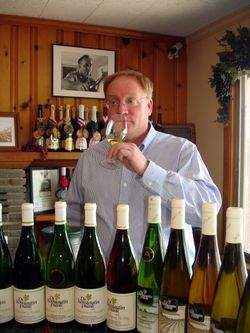 Fred Frank, president of the winery, explained that the wines included in the tasting were not selected based on any notion of vintage quality and ageability. Instead, he related that the winery had varying numbers of bottles reserved from each vintage. With a trade tasting and a consumer tasting both scheduled on the same day, it was necessary to select those vintages that could spare a few bottles and still retain some stock down cellar.
Fred Frank, president of the winery, explained that the wines included in the tasting were not selected based on any notion of vintage quality and ageability. Instead, he related that the winery had varying numbers of bottles reserved from each vintage. With a trade tasting and a consumer tasting both scheduled on the same day, it was necessary to select those vintages that could spare a few bottles and still retain some stock down cellar.
Such practical considerations made for an interesting flight, as the vintages represented both the extremes of the Finger Lakes, hot and dry versus cool and wet, and many points in-between.
The wines tasted, in order, were: 2008 Dry Riesling, 2007 Dry Riesling, 2005 Dry Riesling, 2001 Reserve Riesling, 1991 Dry Riesling, 1988 Dry Riesling, 1987 Dry Riesling, 1985 Dry Riesling, 2007 Semi-Dry Riesling, and the 1995 Semi-Dry Riesling.
The Dry Rieslings
There are nearly an endless number of observations that can be made when one approaches a tasting that has so many variables attached to it. At the most basic level, all of the wines were interesting and enjoyable, which is a result that should never be taken for granted.
Starting with the newer vintages, I detected the flavors and descriptions that are often attached to a Finger Lakes riesling. In the 2008, 2007 and 2005 dry rieslings, the noses had hints of apple blossom, followed by tastes of melon and citrus backed with varying degrees of acidity and minerality.
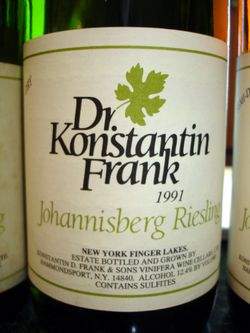 As I have observed in the past with many other Finger Lakes rieslings from 2007, this wine was all about fruit but with less acidity and minerality, a combination that I do not enjoy as thoroughly. Of the more recent vintages, the 2005 was definitely the strongest, with an almost perfect balance of minerality and fruit and a full mouthfeel. The 2008 was very good but still in bottle shock, so future judgments await.
As I have observed in the past with many other Finger Lakes rieslings from 2007, this wine was all about fruit but with less acidity and minerality, a combination that I do not enjoy as thoroughly. Of the more recent vintages, the 2005 was definitely the strongest, with an almost perfect balance of minerality and fruit and a full mouthfeel. The 2008 was very good but still in bottle shock, so future judgments await.
When we jumped from the 2005 to the 2001, the nose and flavors shifted considerably. The 2001 had a mellow fruit component, more akin to pear than melon or critrus. I also detected a hint of honey and toasty herbs. The wine possessed tremendous backbone and a compelling but austere finish.
Skipping another ten years, the 1991 exploded with similar toast and honey flavors, striking the mid-palate with a viscous butterscotch that dripped into a long finish that evolved and evolved. This was an excellent and well-aged wine that exhibited complexities that one might not associate with a newer riesling.
The 1988 and the 1987 were somewhat similar and in that sense exciting. Both wines showed the butterscotch flavor, although the nose on the 1988 was a bit sharper (it reminded me of mint) and also had a lingering finish. The 1987 had just a touch of petrol (the only wine to really show this quality) and had a finish that did not linger but was narrow, well-defined, and drying.
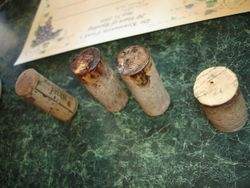 We arrived at the 1985 with the anticipation that enthusiasts naturally lend to the oldest wine in a group. Unfortunately, the floral nose led to a wine that had passed its prime. A second bottle was opened, to a similar effect. Fred Frank expressed some measured disappointment and began to show us the corks from these bottles which were intact but obviously pushed to their limits. Some oxidation likely occurred, but the wine was still drinkable and worth considering. As I stated to one of my tasting companions, "A dying good wine is better than a new bad one."
We arrived at the 1985 with the anticipation that enthusiasts naturally lend to the oldest wine in a group. Unfortunately, the floral nose led to a wine that had passed its prime. A second bottle was opened, to a similar effect. Fred Frank expressed some measured disappointment and began to show us the corks from these bottles which were intact but obviously pushed to their limits. Some oxidation likely occurred, but the wine was still drinkable and worth considering. As I stated to one of my tasting companions, "A dying good wine is better than a new bad one."
Of course the 1984, if tasted, could have been wonderful, or maybe an even older vintage as well. Or perhaps a third bottle of 1985 might have done the trick. This isn't an exact science! All in all, I was very happy that we tasted to nearly 25 years with some amazing results.
The Semi-Dry Wines
The winery reserved the two semi-dry rieslings for the end of the tasting believing that they would have a different overall profile. For the most part, this predication held true. The 2007 semi-dry riesling was a knockout, with powerful lemon and citrus flavors backed by a touch of sweetness and hint of acidity and minerality. This wine was in tremendous balance and demonstrated to me, again, that on the whole I prefer 2007 semi-dry reislings to their dry counterparts from the same vintage. This wine is a must-have.
The 1995 semi-dry riesling was like molasses wrapped in fruit, possessing a solid structure and tremendous mouthfeel that led to a pleasing and lingering finish. This wine was an example of what a slightly sweet aged riesling can accomplish, and I wish we had not tasted this last as I think it might have held up very well in direct comparison to some of the dry riesling results in vintage order.
Conclusions and Observations
It's difficult to come to any specific conclusions about this exercise. As in all large tastings I felt humbled by the varying tastes and questioned constantly my ability to sort through all of the sensory information. Based on the conversations during the tasting, however, most of the participants reached similar conclusions about the general shift in aromas and flavors as the vintages became older.
I am now more convinced than ever that a well-made riesling can easily age 10-20 years and that riesling can take on an entirely different characteristics between the 10 and 20 year mark. Based on this experience and others, I dare say that Finger Lakes rieslings can age and they age well, offering a new dynamic to an already complex and satisfying white.
Which of the wines was the most significant stand-out? I'd have to say that the 1991 was the most interesting in that its complex tastes and aromatic qualities formed a perfect bridge between the elements of a newer rieslings and the intense flavors of an older version. The wine was just so perfect right now.
Fred Frank graciously revealed that the 1991 riesling was made in large part by Peter Bell, currently the head winemaker at Fox Run Vineyards.
…and a little surprise…
At the very end of the tasting, the group was treated to a yet-to-be-released 2008 Late Harvest Riesling made in the traditional Trockenbeerenauslese style.
Wow.
The botrytis just plain kissed these grapes, providing a sweetness of such depth and luxury that I wanted to demand another glass. Yes, the wine is that good even in its newly-bottled youth.
The winery is unsure of the eventual release price, and while I would hope that the wine remains affordable, I imagine they will find some buyers who are willing to take the plunge.
Rumor has it that 2008 was a great year for late harvest and ice wines. If Dr. Frank's late harvest is typical of the vintage than these wines will be prized indeed.

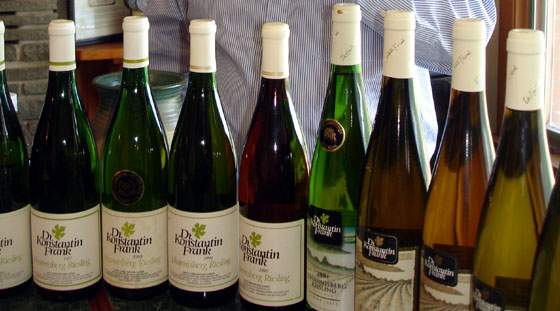














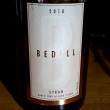
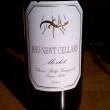

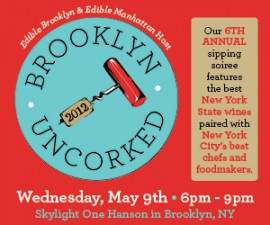

What a cool event, Jason. We had to divide and conquer the Riesling verticals, but this is hard to beat.
I wonder: With the success of Riesling verticals this year, will wineries be able to do one every year? They risk depleting libraries, I suppose. All the more reason to build better libraries in the first place.
I imagine that wineries will try to maintain at least an extra case or two per vintage now that retaining a few extra bottles has been proven to have some good PR value…these events are at the very least interesting.
In the near future, however, I suspect you are right that it’s going to be hard to do these library tastings year after year instead of every few years. Hopefully wineries will keep a record of such events on hand and keep the story about ageability circulating.
Evan and Jason,
As we look to further develop Riesling Month in the Finger Lakes, vertical tastings will certainly play a part. We hope to have many of these special tastings in the calendar by January.
Thanks for the great coverage of all these tastings. Hopefully several more wineries will participate next year!
Morgen
I was also at this tasting, and I concur with overall observations that Jason put forward. I have only a few differences with him in the descriptions, but that is how palates go. To me, ‘minerality’ ran down the spine of most of the wines, which is a good thing.
As to the 1985 wines, it wasn’t a matter of “some oxidation” having occurred. For whatever reason-and cork is the likely suspect-each wine showed clear signs of a large measure of oxidation, and I didn’t find anything floral about the nose, mainly that acrid residue that oxidation gives to aroma.
It was too bad, because I remember the 85 vintage, and it was a pretty good one.
In all, the tasting showed very well how Keuka Lake Rieslings age.
Thanks for adding your observations, Thomas. I would agree that minerality ran down the spine of all these wines (even if I didn’t mention it each time), although I found it a bit lacking in the 2007 dry. As for the rest of the wines, it’s there!
Now that I think about it, I caught the fleeting floral nose only on the first 1985. On the second try, not at all. The second definitely hit me with the acrid smell you described!
It was definitely fun.
As you know, Jason, one of the interesting things about this tasting was the influence that a few separate winemakers had on individual wines. Yet, that Keuka minerality stayed through it all, which is the regional identity that, in my opinion, the wineries should be touting over and over. It is the signature.